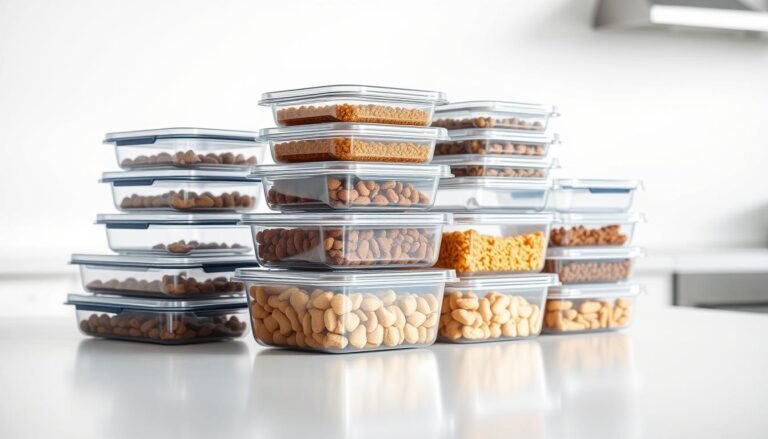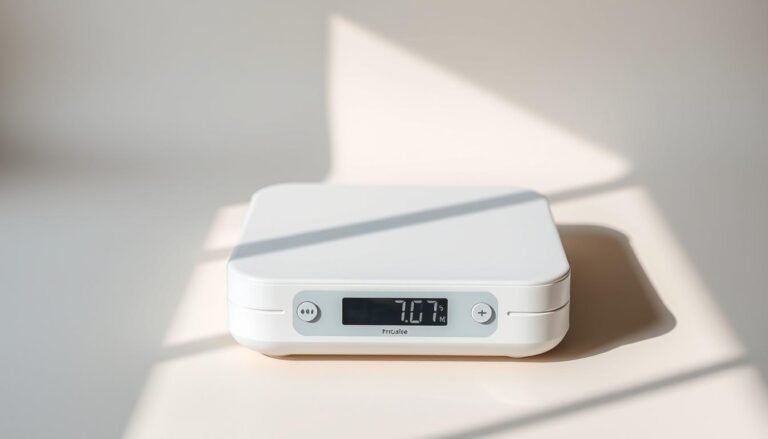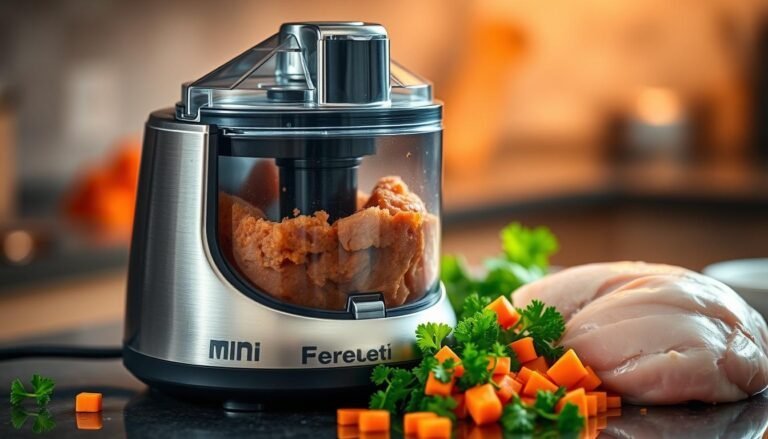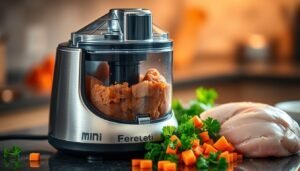Cooking healthy, pet-friendly meals at home is great for your pet’s health. Many pet owners now make their own food. They use the Slow Cooker and Instant Pot to make meals that fit their pet’s needs.
With a Slow Cooker or Instant Pot, you can make tasty, healthy recipes for your pet. Homemade pet food can make your pet healthier and give them the right nutrition. For example, a site called Holistic Vet Blend shows how these appliances help with pet food.
Key Takeaways
- Cooking pet-friendly meals at home allows for tailored nutrition.
- Slow Cookers and Instant Pots are ideal for preparing healthy pet meals.
- Homemade pet food can lead to improved health outcomes.
- Using the right appliance can make a difference in cooking time and efficiency.
- Pet owners can benefit from the flexibility and convenience of these appliances.
The Benefits of Homemade Pet Food
Homemade pet food has many benefits. It meets specific dietary needs and strengthens the bond between pets and their owners. By making meals at home, owners can give their pets the nutrients they need. They avoid additives found in some commercial foods.
Health Advantages Over Commercial Options
Homemade pet food has health benefits over commercial options. Commercial foods may have preservatives, fillers, and by-products that are not good for pets. Homemade meals use fresh, whole ingredients. This reduces the risk of bad reactions to these additives.
Control Over Ingredients and Quality
Preparing pet food at home means owners have complete control over ingredients and their quality. This is great for pets with allergies or sensitivities. Owners can avoid ingredients that cause reactions. Using high-quality ingredients ensures pets get the best nutrition.
Addressing Specific Dietary Needs and Allergies
Homemade pet food lets owners tailor meals to their pet’s needs. Whether it’s for allergies, digestive issues, or health concerns, meals can be adjusted. This personalized nutrition can improve pets’ health.
Strengthening the Human-Animal Bond Through Food
Preparing homemade meals for pets can strengthen the bond between pets and their owners. Cooking and sharing meals can deepen their emotional connection. It promotes a deeper understanding and affection between them.
Understanding Your Pet’s Nutritional Needs
It’s key to know what your pet needs to stay healthy. Pets need different foods based on their type, age, size, and health.
Essential Nutrients for Dogs
Dogs need a mix of proteins, fats, carbs, vitamins, and minerals. Proteins are very important for their muscles. Foods with omega-3 fatty acids, like fish oil, help their skin and coat.
Essential Nutrients for Cats
Cats must eat a lot of protein from meat. Taurine in meat is good for their heart and eyes. They also need vitamins and minerals.
Considerations for Small Pets (Rabbits, Guinea Pigs)
Small pets like rabbits and guinea pigs need special foods. They should eat a lot of hay, veggies, and some special pellets. They also need fresh water and veggies for their health.
It’s important to talk to your vet about your pet’s diet. They can suggest the best food for your pet’s health.
| Pet Type | Essential Nutrients | Dietary Recommendations |
|---|---|---|
| Dogs | Proteins, Omega-3 fatty acids | Balanced commercial dog food or homemade recipes with veterinarian approval |
| Cats | High protein from animal sources, Taurine | High-protein commercial cat food or appropriately formulated homemade diets |
| Rabbits, Guinea Pigs | High fiber, Vitamin C | Hay, fresh vegetables, limited pellets |
By knowing and meeting your pet’s nutritional needs, you can help them live a long, happy life.
Slow Cooker vs. Instant Pot: Which is Better for Pet Meals?
Choosing between slow cookers and Instant Pots for pet meals is important. Each has its own benefits and drawbacks. This is especially true when making food for pets.
Slow Cooker Advantages for Pet Food
Slow cookers cook food slowly at low temperatures. This is great for pet meals that need gentle cooking to keep nutrients. Key advantages include:
- Enhanced flavor due to the slow cooking process
- Ability to cook a variety of ingredients, including tougher cuts of meat
- Ease of use, as ingredients can be added in the morning and be ready by evening
Instant Pot Benefits and Time-Saving Features
The Instant Pot is a pressure cooker that cooks food fast. It’s perfect for pet owners who are short on time. Notable benefits include:
- Rapid cooking times, ideal for busy pet owners
- Versatility in cooking a wide range of pet food recipes
- Energy efficiency due to shorter cooking times
Cooking Time and Temperature Comparisons
It’s important to look at cooking time and temperature. Slow cookers cook at lower temperatures for longer. Instant Pots cook at higher temperatures and pressures, making them faster. This comparison is crucial for pet owners to decide based on their pet’s nutritional needs.
Energy Efficiency and Cost Considerations
Energy efficiency is key. Instant Pots use less energy because they cook faster. This could save money over time. But, the initial cost and the pet owner’s needs should also be thought about.
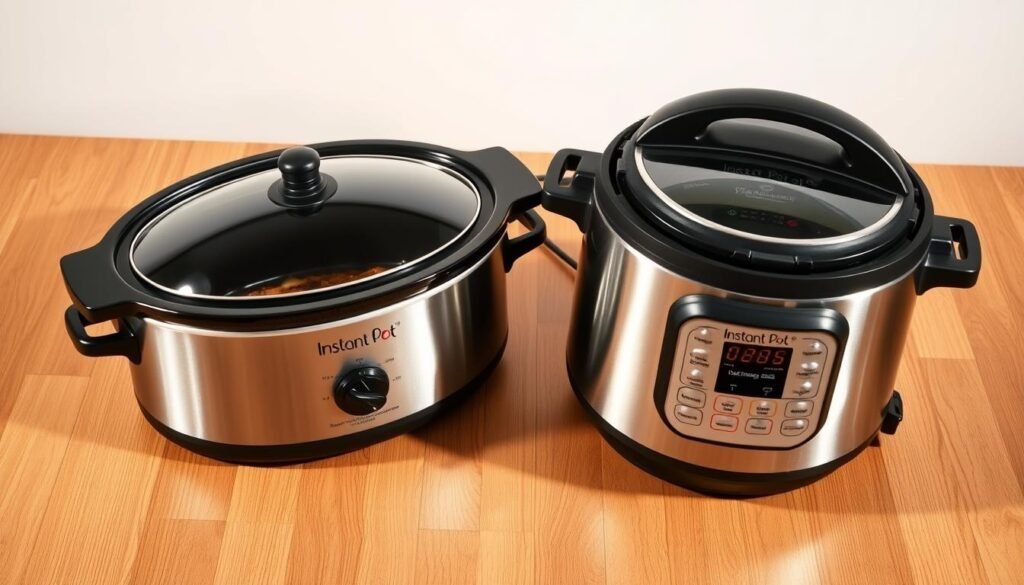
In conclusion, both slow cookers and Instant Pots are good for making healthy meals for pets. The choice depends on the pet owner’s needs and preferences. This includes cooking time, energy efficiency, and the pet’s nutritional needs.
Safety Considerations When Cooking for Pets
When cooking for pets, safety comes first. It’s key to make sure the food is safe and healthy. This helps keep pets safe and well.
Toxic Ingredients to Always Avoid
Some foods are bad for pets. Onions, garlic, and chives can harm their blood. Chocolate is also dangerous because of its theobromine.
It’s important to know which foods are toxic. This helps avoid poisoning pets by mistake.
Proper Food Handling and Contamination Prevention
Keeping pet food clean is very important. Use airtight containers for food and wash your hands often. Clean all surfaces and tools well.
Appropriate Portion Sizes by Weight and Activity Level
Finding the right food amount is key. It depends on your pet’s weight, age, and how active they are. Talk to a vet to set up a good feeding plan.
Balancing Homemade Meals with Supplements
Homemade meals are good, but might miss some nutrients. Supplements can help. But, always check with a vet first. They make sure supplements are safe and right for your pet.
Essential Equipment for Preparing Pet-Friendly Meals
A slow cooker or Instant Pot is key. But, other tools can also help. The right tools make preparing meals for pets easier and better.
Beyond the Slow Cooker or Instant Pot
Other tools can improve your pet food prep. You’ll need storage containers, measuring tools, and gadgets. These make the process smoother and faster.
Storage Containers and Portioning Tools
Storage Containers: Airtight containers keep food fresh and safe. Choose ones that are tough and BPA-free.
Portioning Tools: Tools like measuring cups or ice cube trays help with portion sizes. They ensure your pet eats the right amount every time.
Measuring and Food Preparation Tools
Measuring Cups and Spoons: Accurate measuring is key for balanced nutrition. Use cooking-grade measuring cups and spoons.
Food Processors or Grinders: If your pet needs ground food, a processor or grinder is a must.
Optional Gadgets That Make Pet Food Prep Easier
- Food scales for precise ingredient measurement
- Silicone spatulas for easy food handling
- Label maker for dating and identifying stored meals
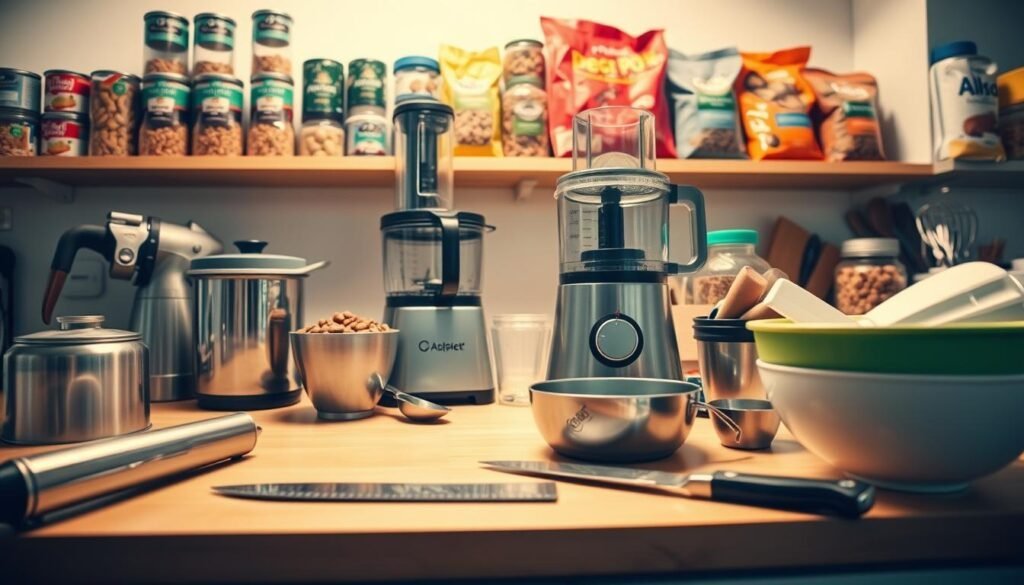
Good equipment makes pet food prep easier. It ensures your pets get healthy, homemade meals. The right tools improve your pet’s health and happiness.
Slow Cooker or Instant Pot for Cooking Pet-Friendly Meals: Best Practices
Using a slow cooker or Instant Pot for pet meals needs careful planning. You must prepare, cook, and store the food right. This ensures your pet gets a healthy, balanced diet.
Preparation Techniques for Maximum Nutrition
Getting the most nutrition for your pet starts with good preparation. Pick fresh, quality ingredients and chop them right. This way, veggies cook evenly and meats stay safe from germs.
- Choose fresh, seasonal ingredients to maximize nutritional value.
- Handle ingredients safely to prevent cross-contamination.
- Chop ingredients into uniform sizes for even cooking.
Cooking Temperature Guidelines for Safety
It’s important to cook food to the right temperature for safety. Use a thermometer to check the food’s internal temperature. For most meats, it should be at least 165°F (74°C). Follow the Instant Pot and slow cooker guidelines to hit these temperatures.
Cooling and Storing Prepared Meals
After cooking, cool the meals quickly and store them safely. Split big batches into smaller ones and refrigerate or freeze. Always label containers with dates and what’s inside.
- Cool cooked meals to room temperature within two hours.
- Store meals in airtight, shallow containers to facilitate cooling.
- Label and date all stored meals for easy identification.
Maintaining Consistency in Your Pet’s Diet
Keeping your pet’s diet consistent is key to their health. Use the same recipes and ingredients to keep nutrition levels steady. Adjust recipes as your pet grows or their health changes.

By sticking to these best practices, you make sure your pet’s meals are tasty, safe, and nutritious. Always talk to your vet to make sure the diet fits your pet’s needs. This way, your pet gets the best care through their food.
Dog-Friendly Recipes for Both Appliances
Cooking for your dog is now easier with simple recipes for slow cookers and Instant Pots. These appliances help make healthy, homemade meals for your dog. Here are some tasty and nutritious recipes to start with.
Slow Cooker: Chicken and Rice Meal
This recipe is a classic comfort food for dogs. It’s easy to make and full of nutrients.
- 1 lb boneless, skinless chicken breast or thighs
- 2 cups cooked white or brown rice
- 1 cup mixed vegetables (carrots, peas, green beans)
- 1 teaspoon fish oil
Put all ingredients in the slow cooker. Cook on low for 4-5 hours. Serve warm.
Instant Pot: Beef and Vegetable Stew
This stew is a great way to add variety to your dog’s diet.
- 1 lb beef stew meat
- 1 cup mixed vegetables (sweet potatoes, carrots, green beans)
- 2 cups beef broth
Cook on high pressure for 20 minutes. Let the pressure release naturally. Serve warm.
Slow Cooker: Turkey and Sweet Potato Dinner
This meal is nutritious and flavorful, perfect for a special dinner.
- 1 lb ground turkey
- 1 large sweet potato, peeled and diced
- 1/4 cup canned pumpkin
Cook on low for 6 hours. Serve warm, mashed, or as is.
Instant Pot: Lamb and Quinoa Bowl
This meal is rich in protein and easy on the digestive system.
- 1 lb lamb, cut into bite-sized pieces
- 1 cup quinoa, rinsed
- 2 cups lamb or chicken broth
Cook on high pressure for 15 minutes. Then, let it release naturally for 10 minutes. Serve warm.
These dog-friendly recipes are not only tasty but also healthy. Using your slow cooker or Instant Pot ensures your dog gets the best nutrition.
Cat-Friendly Recipes and Considerations
Cats need special food to stay healthy. Making homemade meals for them can help. This way, they get the nutrients they need.
Instant Pot: Fish and Pumpkin Blend
A simple and nutritious recipe for cats is an Instant Pot fish and pumpkin blend. This dish combines the protein-rich benefits of fish with the digestive benefits of pumpkin.
Slow Cooker: Chicken Liver Pâté
Another delicious option is a slow cooker chicken liver pâté. This recipe is rich in protein and can be a great way to provide cats with a tasty and healthy meal.
The Importance of Taurine in Cat Diets
Taurine is an essential amino acid for cats, playing a critical role in heart health and vision. Ensuring that cat meals include taurine is vital for their overall health.
Texture Preferences and Serving Suggestions
Cats often have preferences when it comes to the texture of their food. Some may prefer smoother textures, while others like it chunkier. Observing your cat’s preferences can help you tailor their meals to their liking.
Some key considerations for cat-friendly recipes include:
- Using high-quality protein sources
- Incorporating essential nutrients like taurine
- Paying attention to texture preferences
Batch Cooking and Meal Planning for Pets
Batch cooking and meal planning make pet nutrition easier. They help pets stay healthy and happy. By cooking meals ahead, owners can give pets good food every day without stress.
Weekly Meal Prep Strategies
Start with a good meal plan for batch cooking. Think about your pet’s needs, diet, and likes. A weekly plan might include:
- Choosing a day for cooking and prep
- Cooking big batches of one recipe or small batches of different ones
- Dividing meals into single servings
Freezing and Thawing Guidelines
Freezing and thawing meals right is key. Use airtight containers or freezer bags to keep meals fresh. Thaw in the fridge or cold water, changing water every 30 minutes.
Rotating Proteins and Vegetables for Nutritional Variety
Change up proteins and veggies in meals for a balanced diet. Try chicken, beef, fish, and lamb for proteins. Use sweet potatoes, carrots, and green beans for veggies. Talk to a vet to find the best mix for your pet.
Cost Analysis and Budget-Friendly Tips
Batch cooking saves money, especially with bulk buys and seasonal produce. Use cheap proteins like chicken and beans. Plan meals with what you already have.
Common Mistakes to Avoid When Cooking for Pets
When cooking for your pets, watch out for common mistakes. This ensures their nutritional needs are met. Cooking for pets can be a great way to give them healthy meals. But, knowing the mistakes can help keep them healthy.
Nutritional Imbalances and How to Prevent Them
Nutritional imbalances happen when diets lack or have too much of certain nutrients. To avoid this, learn what your pet needs based on their type, age, size, and health. A vet can help you make a balanced diet.
Over-Reliance on Single Ingredients
Using only one ingredient can cause nutritional gaps. For example, chicken-only diets might miss out on other important nutrients. Mix different ingredients to ensure a wide range of nutrients.
Improper Food Storage and Safety Issues
Bad food storage can cause contamination and spoilage. Always keep food in airtight containers in the fridge or freezer. Follow safe thawing methods.
Ignoring Changes in Your Pet’s Health or Behavior
Changes in your pet’s health or behavior might mean diet problems. Watch your pet closely and change their diet if needed. Always get a vet’s advice.
Conclusion
Using a Slow Cooker or Instant Pot for pet meals is rewarding. It gives your pets the nutrition they need to be healthy. Homemade pet food has many benefits, like better health and a stronger bond with your pet.
A study by the American Veterinary Medical Association showed many homemade dog foods lack nutrients. It’s key to use balanced recipes from experts, like board-certified veterinary nutritionists. For more info on healthy dog food, check out Just Food for Dogs.
By following these guidelines and recipes, you can make tasty, healthy meals for your pets. Start cooking for your pets today. Enjoy the benefits of a well-nourished companion.
FAQ
What are the benefits of cooking pet-friendly meals using a slow cooker or Instant Pot?
How do I ensure my pet is getting the nutrients they need from homemade meals?
What are some common mistakes to avoid when cooking for pets?
Can I use a slow cooker and Instant Pot for both dogs and cats?
How do I store and handle homemade pet food to maintain its nutritional value?
Are there any specific ingredients that are toxic to pets that I should avoid?
How can I ensure my pet’s diet is balanced and complete?
Can I batch cook and freeze homemade pet food for later use?
How often should I rotate my pet’s protein sources and vegetables?

Ryan Conlon is the founder of PetFriendlyRecipes.com, a resource dedicated to helping pet owners create simple, healthy meals and treats at home. With a background in web publishing and a focus on practical content, Ryan built the site to make homemade pet food easier to understand and more accessible for everyone.
Subscribe to Our Newsletter

